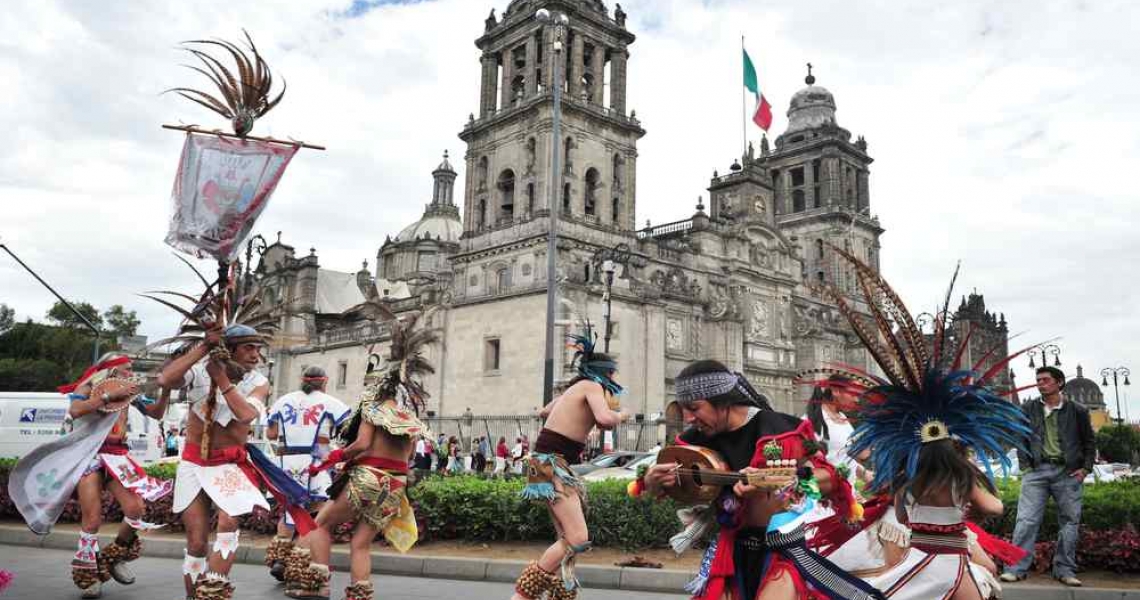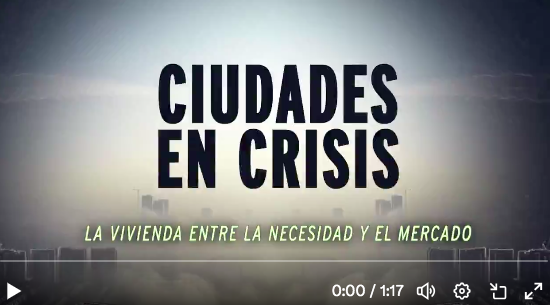
MEXICO CITY— When Mexico City this month became one of
the few cities in the world to have a constitution, it surprised many by
including explicit reference to a “right to the city”, a touchstone progressive
idea aimed at ensuring that urban areas protect their most vulnerable
communities.
For
instance, the right would require that city officials study the impact of major
urban development efforts that often result in the displacement of poor
communities. This approach would mandate that, at minimum, those communities
are relocated to areas that would not continue or worsen their economic, social
or spatial marginalization.
The new
constitution, which was formally adopted 5 February, states that
Mexico City guarantees the right to the city. The idea received landmark recognition
during last year’s negotiations on the New
Urban Agenda, the global strategy that seeks to guide sustainable
urbanization over the next 20 years. Mexico played a key part in that process,
including as a prominent proponent of urban rights.
[See: The people power behind Mexico City’s new
constitution]
Now,
little over three months after the New Urban Agenda was adopted, the Mexico
City constitution is one of the few legal documents anywhere to guarantee this
complex right, which remains unrecognized by international law.
“The
right to the city is a collective right that guarantees the full exercise of
human rights, the social function of the city, their democratic management and
ensures territorial justice, social inclusion and the equitable distribution of
public goods with the participation of citizens,” the constitution states.
The
“social function of the city” refers to a concept, particularly strong in Latin
America, that the private ownership of land should somehow benefit the city’s
residents as a whole.
Value capture?
This is
clearly far-reaching language, at least on its face. To actually implement many
of these guarantees, however, will require new funding. And on this point, the
Mexico City constitution came up only middling.
That
wasn’t for lack of trying. For months, for instance, officials wrangled over
whether and how to include reference to a key potential method for paying for
such programmes: land-value capture. This strategy, which has seen successful
application in other parts of Latin America and Europe, allows a city
government to collect a percentage of real estate gains derived from public
investment in urban improvements — parks, public transport, water and sewage,
and more.
[See: How São Paulo uses “value capture” to raise billions
for infrastructure]
While
this proposal did receive significant political support, it ultimately failed
following an enormous lobbying effort by the real estate industry. Deputies
from the Institutional Revolutionary Party and the National Action Party, which
belong to the opposition in the city’s assembly, opposed the mechanism.
The
proposal also was the subject of competing petitions on the Change.org
platform. One of the filings in favour of the measure argued that “today, public investments
do not benefit equally to all. In addition, we live through a planning lottery:
Changes to the use of land and the increase in the densities of construction
[result in] just a few getting the biggest cut.” On the other hand, the
petition went on, “normal people” get only “a small apartment or the hard life
on the periphery. With the recovery of the land value, it is possible to
correct these inequities without affecting the value of the housing market.”
Meanwhile, a petition opposing value capture titled “Goodbye to private property in
Mexico City” questioned whether “we, as citizens”, living in certain areas,
“lack right to that value?” It argued that “urban improvement work that may be
made in our neighbourhoods already comes from other taxes, which were already
paid, so the proposed land-value capture in favour of the public administration
should be eliminated” from the Constitution. That petition received the support
of more than 80,000 people.
Filling in the details
Nonetheless,
in the end the city constitution did take some progressive financial steps. The
document, which is to come into effect in September 2018, stipulates that
owners of real estate will be obligated to pay a certain amount to mitigate
environmental and what the constitution terms “urban impacts”. In turn, those
funds are to be used on urban development and improvement projects,
particularly around streets, water infrastructure and public space.
“The
law shall regulate the obligation of owners of real estate developments to pay
monetary compensation to mitigate environmental and ‘urban impacts’ in order to
contribute to the development and improvement of urban equipment, road and
hydraulic infrastructure and public space,” the text states.
[See: Historic consensus reached on ‘right to the city’ in
New Urban Agenda]
Despite
these steps, much remains up in the air. For instance, the constitution does
not offer a definition of what, exactly, constitutes “urban impacts” — an
important issue that will remain up to future policy-making processes.
Lawmakers also will need to determine a formula by which these new revenues
will be used. “The law shall establish the formula and criteria for the
application of such income in the areas of influence or affectation, in
conditions of equity, transparency and accountability,” the constitution
stipulates.
Even
once clarity is brought to those issues, many still foresee structural
obstacles looming. For Enrique Provencio, president of the Urban Development
Commission that assisted in writing the new constitution, the city will need to
improve its tax capacity and budget execution if it wants to take advantage of
the new provisions.
“The
legal framework should be upgraded, so that the constitution will be complied
with,” he hold Citiscope. “The approved rights suppose a more progressive
fiscal approach. The city needs a better policy of tax collection, and more
efficient measures to reduce tax evasion and elusion.”
Still,
in recent years the city has built up a series of instruments that may help to
finance these new guarantees. A new law on housing, approved in December by the
city assembly, contains a provision to recover a portion of land gains. In
addition, the city’s new tax code raises the levy on property ownership to
between 4 and 10 percent, depending on the land’s value.
[See: So how do we implement the ‘right to the city’,
anyway?]
Both
are provisions recommended in the New Urban Agenda. Indeed, much of the city
constitution appears to draw directly from the agenda on issues related to
urban development, zoning, housing and the so-called social construction of habitat.
The
action that Mexico City is trying to take is notable in the context of the
national government’s relative lack of action so far on implementing the New
Urban Agenda. The national committee formed for the Habitat III process hasn’t
yet been reactivated with an eye to implementing the agenda, which also hasn’t
yet been formally approved by the Mexican Senate.
Taxation question
Much of
Mexico City’s energy in favour of land-value capture and the new provision on
the right to the city has to do with the fact that the city’s land values have
grown exponentially in recent years.
On the
one hand, Mexico City did move to raise property taxes in December. On the
other, at the national level Mexico continues to levy a property tax of just
0.3 percent — the lowest among the OECD grouping of developed countries.
Meanwhile,
Mexico City contributes around 30 percent of the country’s overall land
property tax base. In 2016, the metropolitan administration collected around USD 600
million, a 7 percent jump over the previous year, due to higher rates.
[See: Did Habitat III make progress on the stickiest of urbanization issues —
land reform?]
Other
Mexican cities, too, have been experiencing steeply rising land values in
recent years. And in each of them, according to the World Bank, the poorest
have been forced to pay far more in property taxes than the rich.
“The
financial mechanisms that are going to be introduced are variable,” said
urbanist Silvia Mejía. “Clearly they must allow for access to public space, to
quality transportation, and they must raise the land value where there is such
access, so that the city can reclaim that rising value.”
Mejía,
an adviser to UN-Habitat in Mexico,
defends the implementation of approaches such as land-value capture to support
urban improvements in places like Mexico City — a gigantic metropolis of some 9
million people with enormous demands for water, public transportation, garbage
management and more.
“The
concept is quite new, [although] it’s been used a lot in Europe and in New
York. It’s a contribution that must be collected to guarantee the improvement
of the city,” says Mejía. “It’s important that the citizenry, as they demand
quality public space, contributes — as the city gives to us. If we want quality
services, it’s important that we begin to understand that they need financing.”
[See: How Kampala is building a culture of taxpaying]
Enrique
Ortiz is one of the key figures behind the push to include land-value capture
in the city constitution. “There is impact when big developments affect
services, [when] they’re expanded, like water or sewage,” he said. “Poor people
are displaced, and they need to be relocated with dignity, not to the periphery.
All of that has a cost, and the land-value capture was designed for that.”
Ortiz,
the Latin America project coordinator for the Habitat International Coalition,
says the idea of land-value capture “was meant to benefit a compact city, which
doesn’t leave out certain social sectors. But without a land policy, which
implied [strategies] like land-value capture, this will be difficult to
finance.”
Defining ‘urban impacts’
Going
forward, the Mexico City constitution creates two mechanisms by which to carry
out its key “urban impacts” provision: an Institute of Democratic Planning and
Forward Planning, and a General Programme of Zoning. Once they get up and
running, these are set to operate for 15 years, and their mandates will need to
be updated every five years.
Together,
their impact could be significant. The institute and programme ultimately will
be tasked with, for instance, defining ecological areas for building and non-building
purposes. They also will be the main mechanisms by which the city arrives at a
new calculation for property taxes and urban impacts.
[See: New solutions to close the gap on municipal finance]
The
institution will be overseen by a Governing Board, led by the mayor and
comprising five cabinet representatives, three City Council representatives and
seven citizen advisers. It is now up to the City Assembly to approve a new
planning law, which should allow the institute to go into operation by mid-2019
at the latest.
Thereafter,
a key responsibility for the institute will be to establish a system of
indicators for the new rights guaranteed by the constitution. In turn, those
indicators will allow goals to be set in the annual budget and facilitate
compliance oversight.
The
institute’s members will also design the General Programme of Zoning,
envisioned to be the technical instrument by which authorities will regulate
the city’s transformation and strengthen its “social function”. The programme,
which will take effect in 2021, will be designed in conjunction with the city’s
public administration, neighbourhood councils and citizen input.
While
these processes are still years away,NGOs already are making
plans for how to use any additional revenues coming in through these taxation
mechanisms. Several groups are pushing, for instance, to create a special fund
to finance improvements in transportation, public space, housing and other
urban works.
[See: The New Urban Agenda can strengthen land policies —
with some caution]
Such a
plan could be an interesting way to facilitate urban improvements, said Mejia.
She said it could prove particularly useful in earmarking certain monies.
“If the
resources are labelled and we know where they go, it would be beneficial to the
population and would give [the process] more credibility,” she said. “The
collection of land property taxes is [currently] minimal, so it’s important to
modify this so that people pay the taxes they should.”
She
also suggests another potential mechanism: taxing empty lands, which she says
are encouraging speculation. “That’s another important collection opportunity,”
she said.
Lagging public financing
All of
this is taking place in a context in which financing for public investments is
lagging in Mexico City.
“This
must be oriented to services that offer the greatest opportunity, like public
space, mobility and transportation,” Provencio said. “Land property tax is low,
insufficient. People need to contribute more for the services.”
[See: Mexico seeks to place rights at the centre of the
Habitat III negotiations]
Ortiz
says that the issue isn’t a lack of resources. “The contribution we pay for the
land property tax serves the city’s upkeep — not [to pay for the] impacts of
mega-developments, or for cheap land for the poorest,” he notes.
Rather,
he says, the important thing is how to distribute resources — the priority that
the city puts on investing in inhabitants’ needs, especially for those who are
least developed. “Those who have more, must pay the most — speculators must pay
more.”


